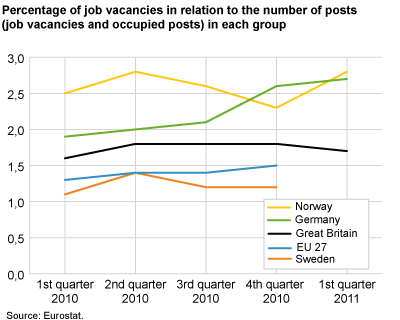Content
Published:
This is an archived release.
Nearly 69 000 job vacancies
There was a growth of about 14 per cent or 8 300 job vacancies from the 1st quarter of 2010 to the 1st quarter of 2011. These are facts drawn from new quarterly statistics from Statistics Norway.
Of all the major industry divisions, administrative and support service activities had the largest number of job vacancies (9 400) in the 1st quarter of 2011. Residential care activities followed with 8 500 job vacancies. Other industries with many job vacancies were domestic trade, professional, scientific and technical activities and construction, with 5 600, 5 200 and 5 100 job vacancies respectively.
As expected, the major industries with the largest number of employees have the largest number of job vacancies. However, in times when the economy is rising, an industry will tend to have more job vacancies. As an example, the construction industry has 13 per cent more job vacancies than manufacturing, despite having 21 per cent less employees than the manufacturing industry in the 1st quarter of 2011.
More job vacancies in private sector and fewer in public sector
The main picture from the 1st quarter of 2010 to the 1st quarter of 2011 is that industries dominated by establishments in the private sector have experienced a substantial growth in the number of job vacancies, while industries dominated by the public sector have experienced a modest reduction.
Vacant job - definitionThe vacancy must be announced, formally or informally. Formal announcements include, for example, advertisements in newspapers, on the Internet, notifying the public employment services or private employment agencies. Informal announcements include, for example, advertisements in shop windows or public notice boards, or announcements via employees, friends or family. Job vacancies exclusively open to internal applicants (within the enterprise, organisation or corporation) are not included in this definition of job vacancies. The post must be paid. Rate of job vacancy - definitionThe number of job vacancies as a percentage of the number of employees + the number of job vacancies. |
Large rate of job vacancies in administrative and support service activities
The rate of job vacancies was 6.9 per cent in administrative and support service activities. Other industries with a large number of job vacancies were residential care activities (6.0 per cent), professional, scientific and technical activities (4.4 per cent) information and communication (4.1 per cent). In education, the rate of job vacancies was low; only 1.3 per cent in the 1st quarter of 2011. This might be due to the fact that most vacancies here are announced in the 2nd quarter of each year. In the 2nd quarter of 2010 the rate of job vacancies was 2.9 per cent, while the corresponding figure in the 1st quarter that year was 1.7 per cent.
Large rate of job vacancies in Germany
Among the countries in the EU/EEA area providing these statistics, Germany had the largest rate of job vacancies; 2.6 per cent, at the 4th quarter of 2010. Norway had 2.3 per cent this quarter. Sweden and Finland had a rate of 1.2 and 1.4 per cent respectively, while Denmark had not published any figures when writing this article. Latvia had the lowest rate of job vacancies with 0.3 per cent, followed by Portugal with 0.4 per cent. The rate of job vacancies in all of the EU member states was 1.5 per cent. Agriculture, forestry and fishing are excluded from this international comparison. More information is available on Eurostat’s website. ( http://epp.eurostat.ec.europa.eu/portal/page/portal/labour_market/job_vacancies ).
Why these new statistics?Information on the number of job vacancies is useful for the study of economic development in a country and for obtaining an overview of the demand of labour force in the different industries. Important users include public authorities, scientists, media, labour and employers’ organisation as well as enterprises, international organisations and the general public. For more information, see About the statistics . |
Tables:
Contact
-
Arbeidsmarked og lønn
E-mail: arbeidsmarked@ssb.no
-
Rakel Gading
E-mail: rakel.gading@ssb.no
tel.: (+47) 40 81 14 75
-
Jan Sebastian Rothe
E-mail: jan.rothe@ssb.no
tel.: (+47) 91 31 99 06

